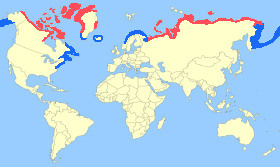Appearance:
Male - The male King Eider has a bluish-grey crown and nape, pale green cheeks, chin and neck are white, breast is white with a salmon-pinkish wash, red beak with a large orange knob which is bordered with black, black body and tail with large white patch either side of the rump, and legs and feet are yellow.
Female - The female has a deep reddish-brown plumage marked with dark chevrons on back and flanks, a grey beak but without the large orange knob of the male, and legs and feet are grey or yellowish. The female resembles the Common Eider.
Eclipse - The male in eclipse plumage has a dark brown plumage with variable white markings on breast and mantle. The wings retain their visible white coverts.
Size: - Typical Adult is 43-63cm (19-25in).
Food: - Molluscs, crustaceans, aquatic insects, larvae, and also a small amount of aquatic vegetation, eelgrass, and algae.
Habitat/Range: - Lakes, pools, and rivers in arctic tundra, coastal areas in Canada, Alaska, Greenland, and northern coasts of Russia, and Siberia. Winters in Aleutians, Bering Sea, St Lawrence Island, west Greenland, Iceland, and northern Norway.

 Breeding Habitat/Resident,
Breeding Habitat/Resident,  Migration or Winter Area.
Migration or Winter Area.Breeding Season: - Mid-June onwards.
Eggs: - 4 to 6 (olive-buff colour).
Notes: - Like the Long-tailed Duck, this species breeds in the extreme north. The King Eider is a large sea duck which is hunted in large numbers in the Arctic during the Spring.
Conservation status (IUCN 3.1):
Least Concern.
Classification: - Family: Anatidae,
Subfamily: Merginae, Genus: Somateria.



 Photo by Neill Smith.
Photo by Neill Smith.
